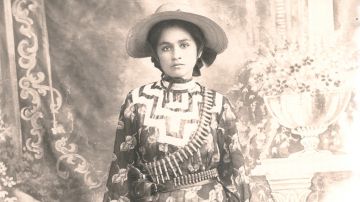3 Generations of Latina’s Explore Mexican Identity With Photography
The moment I walked into the exhibit, Revolution & Ritual at Scripps College, I immediately realized that I know nothing about Mexican history

Photo: Courtesy of pacificstandardtime.org
The moment I walked into the exhibit, Revolution & Ritual at Scripps College, I immediately realized that I know nothing about Mexican history. Although an in-depth knowledge of Mexican history isn’t required to enjoy the beautiful imagery, it sparked my interest in how my Father’s country has evolved. Revolution & Ritual covers the span of over 100 years – the Mexican Revolution to present day – from the perspective of three different generations of photographers; Sara Castrejón (1888-1962), Graciela Iturbide (b.1942), and Tatiana Parcero (b. 1967). A major exhibition from these three female Mexican artists is not only a treat but offers us a rare look at a centuries worth of visual history.
Sara Castrejón
Castrejón was the only woman to document the Mexican Revolution (1910-1920) and is one of the first pioneering female war photographers. Even though she didn’t consider herself a photojournalist, she was the only photographer to capture Mexican armed forces as they passed through her remote city of Teloloapan, Guerrero from the rural Southern vantage point. There are many blurred pictures of the troops marching and riding through the countryside headed to the frontlines, meaning that she was capturing movement in a time when it was very difficult to take non-staged photographs. What I found most interesting was her documentation of the different roles women and children played in the Revolution. Women were typically soldiers and nurses, while children as young as 13 –who had either joined or been forced into the military– were spies, guards, messengers, or stable boys. Castrejón’s photographs of women and children within the Revolutionary efforts are some of the few in existence and many have been seldom been seen in Mexico let alone the US.
wp_*posts
Graciela Iturbide

Iturbide is a critically acclaimed contemporary photographer who has exhibited all over the world. Rural Mexico was the primary focus of her work until she shifted her interest to indigenous communities. You are able to see the progression in her work as well as the shifting themes of colonization and its imposition on the lives, land, and preexisting beliefs of indigenous people. Her work is a critique that through desolate, painful and emotional scenes connects the ancestral past and the capitalistic present in such a way that it demonstrates how they both coexist and fundamentally contradict one another. It is a tension that can only be achieved with skill and a lens of understanding. The images do not judge. Iturbide masterfully creates scenes of symbolic visual conflict that force the viewer to examine why the images make them feel a certain way.



wp_*posts
Tatiana Parcero

Some of the most striking images in this exhibition were of bodies with an overlay of natural, esoteric, and ancient symbols. Parcero is a Mexican photographer living in Argentina, in her photographic history her body becomes the map by which the viewer explores “identity, memory, territory, and time.” Her work deals with the human body, particularly the female body, and it’s interaction with the natural world on a biological and historical level. One of the most interesting pieces was the 19th century cameo style portrait that is in direct response, critique and commemoration of the 2015 disappearance of 43 student teachers from Iguala, Guerrero. It was originally featured in 43 + Uno: Proyecto Fotografico– a collection of images by 44 Mexican photographers that highlighted the need for governmental reform as well as the conflict and violence within the country.

The exhibit will be on display from 08.26.17-01.07.18 – Exhibit is now closed.
Pacific Standard Time: LA/LA is a far-reaching and ambitious exploration of Latin American and Latino art in dialogue with Los Angeles. Led by the Getty, Pacific Standard Time: LA/LA is the latest collaborative effort from arts institutions across Southern California.

















